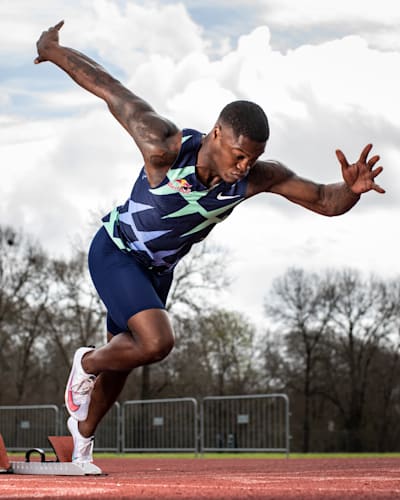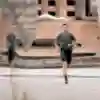
Running
Sprinting techniques for beginners
Keep reading to learn sprint training basics, sprint drills, and other training tips.
Red Bull sprinter Erriyon Knighton knows that the work put into sprinting pays off. Knighton started out as a football player but took up sprinting during off seasons to stay in shape. He explains that what began as a practical training regimen grew into much more.
“After the season is over, you don’t want to just go back to doing nothing. So I kind of just did [track and field] to stay in shape,” he says. “And I found out I was good at it, so I just started to do it every year after that.”
It doesn’t matter if sprinting becomes your full-time passion or just part of your regular exercise routine. You’ll enjoy the rewards that come with getting a little faster and stronger each time you practice. But if you want to run fast and prevent injury, learning proper sprinting techniques for beginners is key.
01
Understanding sprinting mechanics
Before you can sprint correctly and safely, it’s important to understand the basics of sprinting biomechanics. These encompass all the biological factors that impact a runner’s performance. This can include your starting position, reaction time, force production (the power that propels you forward), technique, and neural factors. Environmental factors, such as tailwind, also play a role.
If you understand what drives your own sprinting biomechanics, it’s easier to hone your technique because you know what needs work. For instance, if your reaction time lags, work on refining your speed and mental focus. Then, you’ll be ready to blast off as soon as you hear the word “go.”
Sprinting posture and alignment also have a significant impact on your performance, aiding in efficient force application and longer stride length. Proper running form for sprinters requires your head, neck, and shoulders to be in line with your hips while running with a high knee lift.
02
Warm-up and cool-down exercises
The key to safe and effective sprinting is practicing the right warm-up and cool-down exercises. These help you reach maximum speed faster while minimizing injuries and speeding up recovery.
These are some warm-up exercises you can do before sprinting:
- Jog in place. Steadily raise your heart rate instead of causing a sudden spike by jogging in place for a few minutes.
- Butt kicks. To warm up your hamstrings, stand with your feet hip width apart. Lift your heel and slowly bring it back toward your glutes. Repeat on the other side. Start slow and gradually increase speed over a few repetitions.
- High knees. You can warm up your legs and core by practicing high knees in place. As you raise each knee toward your chest, your quads, calves, hamstrings, glutes, hip flexors, all begin to wake up. You can take these as slow or as fast as you like.
- Lunges. This exercise improves your balance and your range of motion, so you can sprint around curves like a pro. Five reps on each leg is usually an ideal target.
Cooling down is just as important as warming up. It helps your body return to its resting state in a controlled way — which can help prevent injury the next time you sprint. Doing these cool-down stretches can help you recover and regain flexibility after each sprint.
- Slow jog. You can bring your heart rate down with a leisurely paced jog for two to five minutes.
- Quad stretch. You use the quad muscles at the front of your thigh a lot when you run. Put your knees and thighs together for a quad stretch. Hold your right foot with your right hand, lifting your foot toward your bottom. Hold it between 10 and 20 seconds before repeating with the other side.
- Knee to chest stretch. For this stretch, lie on your back with both feet flat on the floor. Lift your right knee to your chest until you feel a stretch in your lower back and hold it there for 10 to 15 seconds before repeating with your other leg.
- Standing lunge stretch. This exercise helps prevent muscle tightness and reduces risk of injury. Lean forward and stretch your left leg forward while keeping your back leg straight behind you. Then, bend your left leg slowly until you feel a stretch in your hips, and hold this position for 10 to 15 seconds. Repeat on the other side.
03
Fundamental sprinting techniques
One of the most important sprinting techniques for beginners is mastering your starting blocks position. Start with all four of your limbs on the ground, while keeping your head and spine straight before lifting off the blocks. This will help you maintain stability and increase power as you propel forward.
Using a phase-based approach to sprinting can further optimize your biomechanics and help you run faster. Maintaining form and speed throughout each phase is very important. You can improve your form by practicing drills in a mirror or working with a coach who can observe you.
The four phases of sprinting are:
- Starting. This is where you begin your sprint from a four-point stance position against the starting blocks. Most sprinters place their dominant leg on the front block for this position. As you push off the blocks, the horizontal force powers you forward.
- Acceleration. This is a transitional phase where you shift from running with horizontal forces to vertical forces. Total leg extension is essential if you want to reach your best speed. You’ll want to lean forward during this phase to get the right angle for achieving momentum.
- Drive. In this phase you run at top speed in an upright position. Keep your spine elongated and your gaze focused forward as you stride toward the finish line.
- Deceleration. Here, you run on low power to the end to combat fatigue and other slow-down factors. You’ll want to keep your knees high and your arms bent at a 90-degree angle to make the most of those final few moments.
04
Breath techniques for sprinters
Mastering your breathing and improving your velocity through speed workouts can dramatically improve your sprinting times.
Breath control for sprinters is very important and can be accomplished by following these tips:
- Take deep breaths through your mouth.
- Expand your stomach with each breath.
- Match your breathing to the pace of your steps.
05
Speed development exercises for sprinters
Optimal breathing is key for peak performance, but so are regular workouts to improve speed. Here are some helpful speed workouts if you’re just getting started.
- Hill sprinting. This workout is good for improving explosive starts in sprinting because the goal is to get farther up the hill with each rep. Hill running works out the muscles in your posterior chain along your spine and the back of your legs.
- Power sprint workout. For this workout, do two intense sprints with a rest in between, then do a steady jog to recover. You can do this for several rounds to improve your sprinting power.
- Descending sprint workout. This exercise is great for steadily increasing speed. You’ll do three rounds of sprints, decreasing the amount of time as you increase your effort, with recovery sprints between each rep.
06
Common sprinting mistakes and how to avoid them
Sprinting isn’t just about having a natural ability to run fast. It involves training using specific techniques to increase speed. You can improve your speed by avoiding these common mistakes and focusing on your form.
Not swinging arms far back enough
Swinging your arms correctly will help your legs pull forward faster. Focus on swinging your arms further back instead of upward. Pretend you’re holding a hammer in each hand and driving nails into a wall behind you.
Sprinting with feet turned out
Running with feet turned out slows you down. To avoid this, practice sprinting on a line and making sure your feet are hitting the ground as parallel to the line as possible.
Low knee lift
Sprinting with a low knee lift makes your strides shorter. You can correct this by warming up with high knee lift exercises.
Landing on heels
The ball of your foot, not your heel, should support most of your weight as you land. If you’re experiencing this issue, high knee and wall drills can help you correct this landing mistake.
Start feeling the benefits of sprinting
Sprinting doesn’t require any additional equipment or a special place — you can run virtually anywhere. You can do it alone or find a team, practice on your own or work with a coach. Whether you’re beating a personal PR or want to get into friendly competition with friends, perfecting your technique is the first step to greatness.
Japanese mountain runner Ruy Ueda embarks on a challenge to run himself into the record books by setting the new fastest-known time for running all of Mount Fuji’s main trails in one stroke. Watch it now on Red Bull TV for free!

23 min
Mount Fuji in One Stroke
Ruy Ueda aims to set the new fastest-known time for running all of Mount Fuji’s main trails in one stroke.














